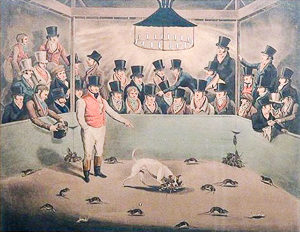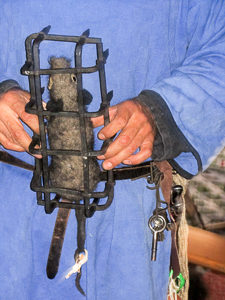Just when you think you’ve seen protests for (or against) about every political, humanitarian, or social issue one can imagine, you run into one which makes you scratch your head and say, “What are those people thinking?” For me this time, it’s about the protests in France supporting the Paris sewer rats. Yep, you heard it here and as I’m fond of saying, “I don’t make up this stuff.” In fact, I read about this topic in a recent article entitled, French Freedom Fighters Press for the Rights of Parisian Rats. I can never resist a good article on French Freedom Fighters.
Seriously, Sandy and I visited Paris last September and we were standing in the small park memorializing the Grand Rafle (click here to read The Roundup and Cycling Arena) and the victims who were detained at the Velodrome before being transported to Drancy and ultimately, Auschwitz. As we were walking through the park, good sized rats scurried about around our feet. It turns out that rats have invaded Paris supermarkets, parks, and nurseries (and I suspect many other venues that no one wants to admit). So, the French politicians held a convention to determine a solution.

The solution was one that likely you and I could easily have figured out sans a convention: poison the rats. That’s when the trouble began. Protestors are against this “inhumane” method of execution (I guess they should not have gotten rid of the guillotine albeit perhaps on a smaller scale to accommodate the rodents’ necks). Instead, they presented their solution to the mayor of the 17th arrondissement (district): rodent birth-control. Once again, I don’t make this stuff up.

And if reading about the rat infestation isn’t enough, you can watch it here.
A NOTE FROM STEW: Hey, if you like this blog or our other blogs, please recommend us to your friends who share the passion for history and in particular, Paris. Your recommendations are greatly appreciated.
Did You Know?
Did you know that there is an “Official Secrets Act” which governs the protection of state secrets and official information? This law is in effect in England and five other countries which make up the United Kingdom. There are four Official Secrets Acts in the United Kingdom: 1889, 1920, 1939, and 1989. Whereas people working with “sensitive” information (e.g., intelligence work) are required to sign a statement stating they agree to abide by the act, it is only done so they remember their responsibilities and obligation under the law. It is designed to prevent espionage and the leaking of sensitive government information. The men and women who worked for the British government during World War II would have been in violation of the law if, after the war, they divulged the information about their jobs. This would have been especially acute with the agents and double agents of intelligence organizations such as MI5, MI6, and Special Operations Executive (read Women Agents of the SOE here). This is one of the reasons why certain memoirs written after the war do not tell the whole story. Wartime information is now being declassified so historians can fill in some of the gaps as well as add to what are extremely interesting stories. One such story is about the Double Cross System or XX System where British double agents convinced the Nazis that the landing site would be Calais. Many of their German handlers died decades after the war’s end without knowing they had been hoodwinked. Only today are historians finding out the details of this deception. Watch for my future blog post on the Double Cross System.
The Rodents’ Defense or “Rats’ Rights”
Rat defenders raise the issue that these animals have the same right to inhabit the city as humans and other animals do. They shouldn’t be subject to cruel and inhumane extermination methods. The Paris municipality says it doesn’t want to completely eradicate the rodent population, only control it—huh? I suppose if the rats had voting rights, the politicians would feel different since it is officially estimated that the Paris rat population is in excess of four million. But the rats can’t vote and that’s why ten protestors stood up in their defense at the arrondissement city hall (an earlier online petition obtained 26,000 signatures in favor of rats’ rights).

As the Paris municipality sees it, their city is ripe for rat expansion: lots of food scraps left by its citizens and the hordes of tourists. The rat has great living accommodations: massive underground systems created since the Romans were there (think about the Phantom of the Opera). The problem they say is that the furry rodents are being forced to the surface because of construction, a rising river, and incorrect garbage disposal methods (ever see the streets on a Wednesday morning in Paris?). The mayor believes the rat population hasn’t grown—it’s only more visible. Watch here.
Rat-Prochement: Save The Rats
Rat-Prochement is one of several protest groups supporting the Paris rat population. It is a 600-member strong social media organization. Their mission is to take in homeless rats. I know that’s a tough job since a survey of Nashville (Tennessee) homeless once concluded that 78% of the city’s homeless liked living on the streets and wouldn’t be happy living like the rest of us. I suppose a current Paris homeless rat survey would yield similar results (plus, show us that they want the right to vote).
However, some of the protestors claim to have rehabilitated individual street rats. The head of Rat-Proachement (a play-on-words for rapprochement—a coming or bringing together—thanks Jeanne!), Ms. Duperret, claims to have saved more than twenty-five rats (assuming the estimate of 4.0 million rats is accurate—which I think is too low—she has saved .000625% of the Paris rat population). Unfortunately, Ms. Duperret has had a difficult time finding places to bury her little friends and some are still in her freezer waiting for a decent burial (I’m sure Père Lachaise Cemetery would take them if she paid for a perpetual lease). Her members also take in former rat pets once the children drop their interest in them and the children’s parents catch the rodents after they’ve escaped from their cage.
Medieval Rats
The rat activists are trying to convince us that rodents got a bad rap in the mid-1300s for spreading the bubonic plague which wiped out about 60% of the European population. I guess with some recent scientific findings, their argument might have some furry legs to stand on.
According to Barney Sloane, author of The Black Death in London, the plague was spread not by rats but by humans or person-to-person. He believes the plague spread too fast to blame the rats and there is no evidence of large scale rat deaths. It would have been lice and fleas on humans which transmitted the disease to others.
On a “glass half-full” note, one of the consequences of the plague was that it effectively ended the feudal system. Additionally, there were more jobs and food for the survivors (and presumably, the rats).

Medieval rats were commonly used for torture. A widely used torture method was to strap the victim down and place a metallic container upside down on their stomach. Inside the container was a rat. The metal would then be heated so the rat would try and escape. There was only one way out for the rat to escape. I believe you can guess the route.
Another Solution to Consider
The mayor of Paris could hire a contemporary of the Pied Piper of Hamelin. You all have heard the story of the piper in the Middle Ages who was hired to rid the town of Hamelin, Germany of its rats, right? He was the village’s mercenary rat-catcher. He did a wonderful job of rounding up all the rats and driving them to the Weser River where they met their demise by drowning. Unfortunately, the villagers refused to pay him for his services. The piper’s motto was, “I don’t get mad, I get even.” And so, he played his magic pipe once more but this time, drove the town’s children into the river where they all drowned like a rat.

By the way, I’ve dedicated this blog to our neighbor, Walt. He is our neighborhood Pied Piper. Fortunately, we only have rats and no children in the neighborhood.
Therapy Rats
So, the next time you get on an airplane and the person sitting next to you has a rat in a cage under the seat in front of them, you will know two things: it is a therapy pet and its owner is a member of Rat-Prochement from Paris. I’d ask to see their therapy certificate signed by a licensed psychiatrist. Then I’d ask to change my seat.
In closing, if you’re planning a trip to Paris in the near future, I hope this blog hasn’t soured you on visiting the City of Light. Remember, rats like darkness and not the light. Wait, maybe I’m thinking of pet therapy cockroaches.
NOTE: The Paris Chamber of Commerce HAS NOT endorsed this blog post.
Recommended Reading
Dalton, Matthew and Josh Jacobs. In France, Even the Rats Have Rights. Wall Street Journal, 11 August 2018.
I’m indebted to Messrs. Dalton and Jacobs for their enlightening article.
What’s New With Sandy and Stew?
Sandy and I are getting ready to go cruising on the Pacific Ocean for seven days with our son and his family. We’re stopping in San Francisco where we will be on the lookout for rats.
Someone is Commenting On Our Blogs
Thank you to Kathy B. for her kind comments on the medieval book. Kathy and Jim were our table mates on the last cruise and I promised I’d send a book to them. Kathy loves Paris and she is someone who has visited the City of Light multiple times. Kathy also enjoys history so, I’ll have to convince her to return to Paris once more but with my books. But then again, after reading this blog, Kathy may not want to return.
If she does, I suggest a walk along the narrow street called Rue de l’Hôtel-Colbert or formerly known as Rue des Rats. Then a stroll over to Place Blanche where a famous café was once located. Its name was Le Rat Mort (The Dead Rat). Nearby was the city’s most famous 19th-century cabaret, Le Chat Noir (The Black Cat). Coincidence? Finally, a visit to the exterminator’s shop at 8, rue des Halles to see the collection of dead rats hanging in the window.

If there is a topic you’d like to see a blog written about, please don’t hesitate to contact me. I love hearing from you so keep those comments coming.
Why Would You Want To Buy Our “Walks Through History” Books?
Simple.
You like to travel and experience history and historical events. You like to see original buildings that had a significant impact on the people and events of the history you’re engaged with. You want to know the stories behind the brick and mortar in front of you.
The walking tour books are meticulously researched so you can go directly to those sites and learn about the building’s history as well as an introduction to some of the more interesting people associated with it.
Thank You
Sandy and I appreciate you visiting with us. We have some exciting things on the horizon and we’ll keep you updated as we go along.
Share This:
Follow Stew:
Find Stew’s books on Amazon and iBooks.
Please note that we do not and will not take compensation from individuals or companies mentioned or promoted in the blogs.
Walks Through History
Copyright © 2018 Stew Ross



Very thorough on those scandalous creatures, Stew. I vote for the Pied Piper.
Hi Regan. Thanks for the comments. Yes, the Pied Piper would be the most environmentally friendly solution. STEW